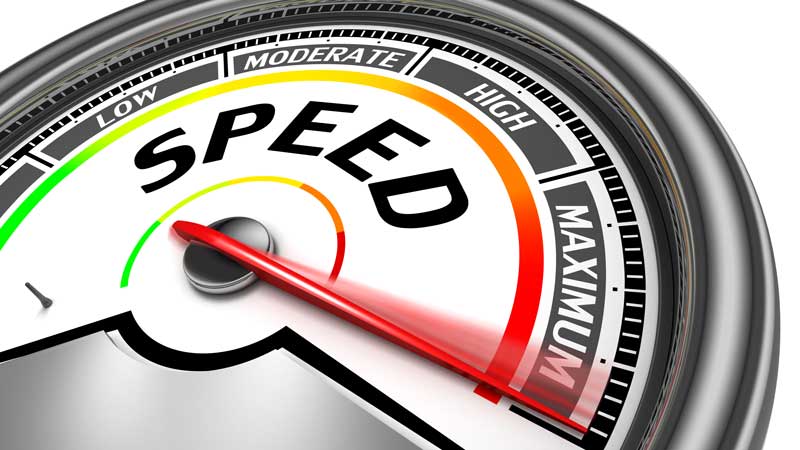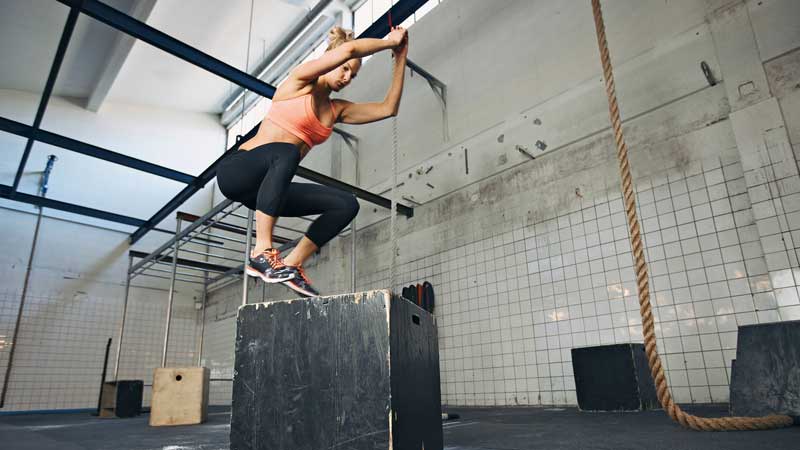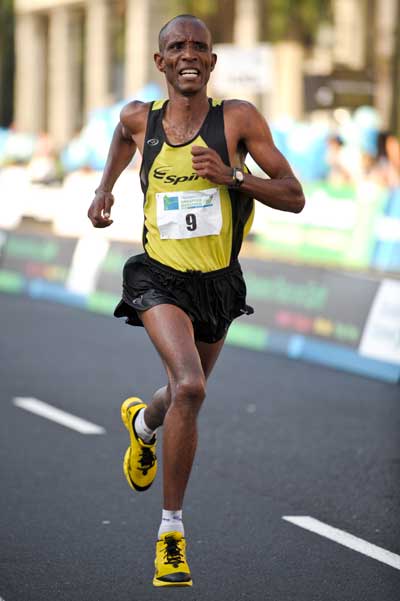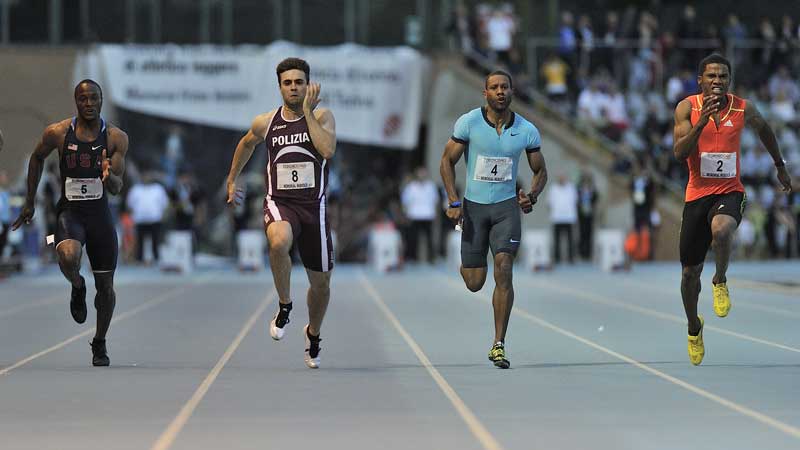
The short answer to this question is an emphatic yes. But that wouldn’t be much of an article, so I probably should expand on that emphatic yes a little bit.
Recently I have been holding some workshops on sprint mechanics for a few groups of people, ranging from strength and conditioning professionals to decent level junior sprinters and Crossfit athletes. All of the seminars were enjoyable and led to some interesting questions and things for me to think about. The Crossfit athletes in particular had some good questions and points to make. Crossfit prides itself on developing an individual’s all round fitness, which includes both speed and endurance. As a result, people taking part in Crossfit need to be proficient in both sprinting and distance running. One of the questions athletes ask me is whether there is an efficient way to combine the two, i.e. do aspects from one area cross over into the other? This got me thinking, so I decided to approach the question of improving distance running as I approach the question of improving sprint performance, which includes:
- Identifying the biomechanical demands, from both the scientific literature, and data
- Identifying what has to happen physiologically to allow the correct biomechanics to occur
- Identify what training can meet these demands.

For sprinting, this is a reasonably simple procedure for me; I look at the data of world-class sprint performance to see what elites are doing. I look at the literature that describes and explains what elite sprinters are doing biomechanically (Ralph Mann’s book The Mechanics of Sprinting and Hurdling is excellent for this). I also looked at what the training literature says I should be doing in my training to achieve these biomechanical values. As an example, negative foot velocity at ground contact is important, with the data indicating that elite sprinter have a higher negative foot velocity than non-elite sprinters. Elite sprinters achieve this by being able to get their thigh higher, which allows a greater range of movement through which they can accelerate the foot. They also tend to have faster angular velocities at both the upper and lower leg, and so strength training should focus on working on this element.
What happens in an endurance race?
In an endurance race, the runners start from a stationary position, accelerate to their running speed, attempt to maintain that running speed for as long as possible, and then, depending on the distance run, possibly have a sprint finish. As the acceleration is such a small part of even the shortest distance event, it’s perhaps not worth dedicating much time to in terms of a training intervention. The sprint finish, again, is such a small part of the race that on the surface it seems like it might not be worth much effort. However, on the home straight races might be won or lost, or places gained or relinquished, so in my opinion it’s certainly a good idea to work on this part of distance performance (although this is probably more of use in track distance races, as opposed to marathons and ultra-marathons).

Copyright Philip Date
Instead, the majority of a distance race is spent running at or close to a constant pace. The faster this constant pace, or the longer the athlete can sustain it, the better the performance. Therefore, it is in the athlete’s best interests to a) run at a quicker constant speed or b) be more economical at their race pace, and therefore more resistant to fatigue. Saunders et al. (2004) found that for two athletes of the same VO2 max, the athlete with a better running economy (RE) was a minute faster over a 10km time trial. They also found that in elite endurance athletes, RE is a better indicator of performance than VO2 max. These results have been replicated in a number of studies, so seem to be scientifically valid.
How can running economy be improved?
There are plenty of factors that have been identified to contribute to improving running economy, both physiological and biomechanical. Not all of them can be improved by sprint training, but some of them certainly can. One of the key kinematic variables related to RE is a low vertical oscillation of body center of mass (Saunders et al. 2004). One way to prevent this vertical oscillation is to ensure that the support leg does not buckle on ground contact, and instead can maintain center of mass height throughout the stance phase. Buckalew et al. (1985) found that, as fatigue increases, the support leg knee bends more during ground contact, decreasing body center of mass (COM) height. A lower COM in turn can decrease stride length (Buckalew et al., Hauswirth et al., 1997). Decreased stride length reduces RE by requiring a greater number of strides to be taken to cover the same distance.
In a review article by Kyrolainen et al. (2000), the authors stated that as well the requirement to maintain a good body center of mass height the neuromuscular system also had to be functioning well. This was shown to be important as it allows for an improved stretch shortening cycle, which in turn increases joint stiffness at both the hip and ankle. Joint stiffness is important as it can store and release energy, requiring less chemical energy while running. Using less energy per step will improve RE.
How can sprint-based training help?
Sprint training could potentially help distance runners in a number of ways. Firstly, it provides a modality through which an athlete can directly work on the sprint finish. As the sprint finish occurs under high fatigue, and is in and of itself very fatiguing, good sprint mechanics in this phase are important. Being able to practice these through sprint training would be helpful.

Copyright Diego Barbieri
Sprint training also increases muscle fiber recruitment. Increased muscle fiber recruitment can help in a few ways, one of which is that it provides more fibers that can be recruited when running at a lower velocity. This improves RE by allowing the athlete to be able to produce slightly more force per step. Being able to recruit more fibers may also help “spread the load” of running, which in turn may help fatigue resistance.
Spending time on sprint-based drills could also be useful. A lot of the sprint drills I do as part of my warm up, and pass on in my workshops, are designed to improve posture, coordination and localized strength and strength endurance. All of these aspects will have a part to play in improving running economy and resistance to fatigue. Sprinting under the watchful eye of an experienced and knowledgeable coach will also enable you to put the technical aspects you have learnt from the drills into practice. Sprint based drills can also teach the athlete to keep the body center of mass high. Drills can also provide some very specific strength work for the support leg, ensuring that the COM does not collapse during the gait. This can help offset or delay the loss of center of mass height that is associated with fatigue. This loss of center of mass is associated with the loss of stride length, which in turn is associated with a decrease in running performance.
Sprinters have long been aware of the benefits of plyometric training, but recently distance runners have been using this training modality to a greater degree. There are a number of studies on distance athletes undertaking plyometric training. Turner et. al. (2003) showed that six weeks of plyometric training improved running economy in distance runners compared to a control group. A study by Saunders et. al. (2006) mirrored this result. The study showed that just three weekly plyometric sessions, lasting thirty minutes each, over a nine-week training block improved running economy at 18km/h in highly trained distance runners. Another group of well-trained competitive distance runners took part in a study by Ramirez-Campillo et al. (2014). After six weeks of explosive strength training, the plyometric group performed better at both a 2.4km run and a 20m sprint when compared to a control group who didn’t take part in the explosive strength training. An important point to note is that none of these studies recorded an improvement in VO2 max from the plyometric training. The improvements in RE were most likely down to an improvement in the stretch shortening cycle. Plyometric training also improves tendon stiffness, allowing the body to both store and utilize elastic energy more effectively. Interestingly, this can mean that the muscles can produce more force without requiring more energy, which has a knock-on effect to RE.
In conclusion, it should be apparent that some form of sprint training can be useful for distance runners. Sprint training could enable an improvement in running mechanics, musculo-tendon stiffness, muscle fiber and motor unit recruitment, and reduce fatigue-related loss of center of mass height. All of these factors can improve running economy, allowing the athlete to improve their performance. Sprint training can also improve the sprint finish for athletes, which could be the difference between winning and losing in a close race.
Please share this article so others may benefit.
[mashshare]References
Buckalew, D., Barlow, D., Fischer, J., & Richards, J. (1985) Biomechanical profile of elite women marathoners. Journal of Applied Biomechanics 1 330-347
Hausswirth, C., Bigard, A., & Guezennec, C. (1997) Relationship between running mechanics and energy cost of running at the end of a triathlon and marathon. Int J Sports Med 18(5) 330-339
Kyrolainen, H., Bell, A., & Komi, P. (2000) Biomechanical factors affecting running economy. Medicine and Science in Sports and Exercise
Ramirez-Campillo, R., Alvarez, C., Henriquez-Olguin, C., Baez, E., Martinez, C., Andrade, D., & Izquierdo, M. (2014) Effects of plyometric training on endurance and explosive strength performance in competitive middle- and long-distance runners. Journal of Strength and Conditioning Research 28(1) 97-104
Saunders, P., Pyne, D., Telford, R., & Hawley, J. (2004). Factors affecting running economy in trained distance runners. Sports Med 34(7) 465-485
Saunders, P., Telford, R., Pyne, D., Peltola, E., Cunningham, R., Gore, C., & Hawley, J. (2006) Short-term plyometric training improves running economy in highly trained middle and long distance runners. Journal of Strength and Conditioning Research
Turner, A., Owings, M., & Schwane, J. (2003) Improvement in running economy after 6 weeks of plyometric training. Journal of Strength and Conditioning Research


